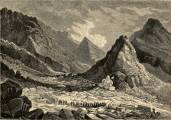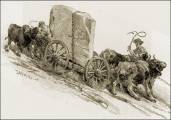


The Connecticut Stone and Building Industry, 1886
Excerpts from
Mineral Resources of the United States, Calendar Year
1886
David T. Day, Chief of Division of Mining Statistics and
Technology
Department of the Interior, United States Geological
Survey
Government Printing Office, Washington, D. C., 1887.
Excerpts from the chapters on 1) Structural Materials, by William C. Day; and 2) Abrasive Materials, by William A. Raborg, and 3) Novaculite, by George M. Turner:
"The year 1886 opened with encouraging prospects for the building industry generally throughout the country, but scarcely were active operations fairly under way when the widely-spread labor disturbances which have made the year memorable began, making themselves felt in a number of the largest cities, both in the east and west. As soon as the labor troubles were inaugurated, many building enterprises were abandoned, and many more were postponed until the differences between labor and capital should be smoothed over. The building operations which were carried on during the period of disturbance were in most cases attended by small margins of profit to all concerned, and in some instances by disaster to contractors and to those who supplied material. Business was dull for all branches of trade connected with the building industry; demand for material was low and irregular, and values fell off quite considerably.
"This period of general depression was, however, followed by one of the greatest activity, and while it is true that many building enterprises contemplated at the beginning of the year were abandoned and not taken up again in 1886, still the fact remains that at the close of the year the showing made by the principal cities of the country was a large increase in the amount of building done, as compared with 1885.
"The kind of buildings most extensively erected during this period of activity consisted of residences, the demand for which, in view of our rapidly increasing population, is naturally at all times imperative.
"Only a few cities show positive evidence to the effect that building operations for the entire year were curtailed owing to the influence of labor troubles, although, of course, the frequently-propounded question, "What would have been the amount and value of building done in 1886 had there been no serious interruption?" is one which no one can satisfactorily answer."
Bridgeport, Connecticut: ".frame buildings formed a large majority of the buildings erected during 1886. The building stone consumed consists of gneissoid rock of good quality quarried locally, Connecticut River brownstone, and also brown sandstone from quarries at Springfield, Massachusetts, and Portland, Connecticut."
"Dwelling houses were in greatest demand during 1886, although some factories were erected. Slate is the favorite roofing material for large buildings, and the demand for it is always good, although it cannot be said to increase rapidly; that from Bangor, Pennsylvania, seems to be preferred, although some from Vermont is also used. The use of ornamental brick and tile has increased markedly during the past years."
"Hartford (Connecticut): For buildings of the better class, brick with brownstone trimmings is largely used. Brown sandstone from Portland, Connecticut, is very popular for trimmings and ornamental stonework; granite from various places on the coast of Connecticut, Massachusetts, and Rhode Island is employed to some extent. For roofing purposes, slate, the demand for which is gradually increasing, is in common use for the better class of buildings; tin and gravel and tar composition are used for flat roofs. The use of ornamental brick and tile is reported as increasing."
"New Haven (Connecticut): In this city, for all ordinary brick work, brick manufactured at North Haven, Connecticut, is extensively employed, while in the best brick buildings pressed brick from Philadelphia and Trenton is liberally made use of for facings; black mortar in brick work is frequently used. Terra cotta has as yet been but sparingly introduced, but ornamental brick is quite popular. The stone employed consists of brown sandstone from Portland, Connecticut, bluestone from the North River quarries, and granite from quarries in Maine, New Hampshire, and Rhode Island. During 1886 small private dwellings and flats took the lead among the various classes of buildings erected. Slate is the favorite roofing material, that from Pennsylvania being preferred; tile is not used; no shingles are allowed on roofs within the city.."
"Quite a marked falling off both in number and value of buildings for 1886 is evident. This is ascribed by local authorities to the influence of strikes and other labor troubles occurring between May and the early part of July."
"For buildings of the better class, brick, with brown-stone trimmings, is generally employed, while granite from Westerly, Rhode Island, and Oneco, Connecticut, is used to some extent. The popular roofing materials are slate and tin, with increasing demand for slate. Ornamental brick is favorably regarded, but tile is not so freely used."
"Besides the Long Meadow stone, bluestone, from Schenectady, New York, sandstone from Connecticut and New Jersey, and granite from Maine are used (in Albany New York)."
Brooklyn, New York: "The stone used in combination with brick is chiefly brownstone from quarries in Connecticut, Wyoming Valley bluestone, and granite from Quincy."
"Among the building materials used (in New York City) brick is, of course, the important material constructionally. Granite is extensively employed in public buildings and large business houses. The Connecticut brown sandstone, which has been so popular for many years, is still extensively employed, also a red sandstone quarried at Belleville, New Jersey. Other brownstones are used to a moderate degree. Among these may be mentioned that quarried in the Potomac range in the District of Columbia, and also stone of fine quality from North and South Carolina."
(In Philadelphia, Pennsylvania) "For foundations of buildings Conshohocken limestone is a common use; for superstructures brick is of course the standard material. Among the stones most abundantly used for superstructures and in combination with brick for ornamental purposes may be mentioned, brown sandstone from Hummelstown, Pennsylvania, and from various quarries in New Jersey, Connecticut, and Ohio."
"The stone (in Savannah, Georgia) now used for building purposes is chiefly Alabama limestone; Connecticut brown stone and Georgia granite have been driven out of use almost entirely."
"For foundations and ordinary work (in Chicago, Illinois) Joliet and Lemont, Illinois, limestone is used; for ornamental work the following are used: Brown sandstone from Connecticut; red sandstone from Long Meadow, Massachusetts, sandstones of all kinds from different sources in Ohio, the Lake Superior region, and, to a less degree and quite recently, from Colorado."
Granite and Allied Rocks:
Production: "The depressing influences which have been felt during a part of 1886 by the quarrying industry as a whole have naturally produced their effects upon the production of granite, and although the total output is unquestionably greater than that of 1885, still it has by no means come up to what appeared to be expected at the beginning of the year. Granite is steadily increasing in popularity as a stone for ornamental and decorative purposes. This statement applies particularly to those varieties which admit of a high polish. A statue of granite is now is now said to cost very little more that (sic) one of marble, notwithstanding the much greater hardness of the former. This, however, may be accounted for in part at least by the fact that much less detail is brought out in granite than in marble sculpture. Granite is produced in eighteen different States; the most important of these are in the order named, as follows: Massachusetts, Maine, Rhode Island, Connecticut, Virginia, and New Hampshire.."
New Hampshire: "Schists capable of being used as whetstones are to be found at Piermont, Lisbon, and Littleton, Grafton county; Tamworth, Carroll county; and Connecticut Lake, Coos county.."
Commercial use of material within this site is strictly prohibited. It is not to be captured, reworked, and placed inside another web site ©. All rights reserved. Peggy B. and George (Pat) Perazzo.